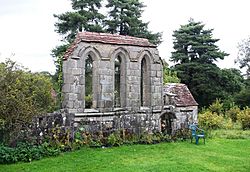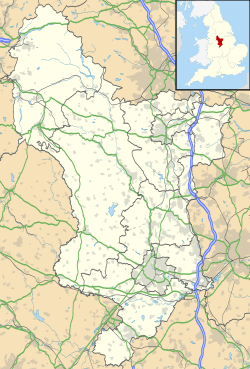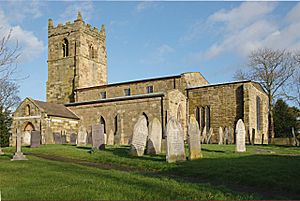Yeaveley Preceptory facts for kids

The remains of the Preceptory
|
|
| Monastery information | |
|---|---|
| Other names | Stydd Preceptory The Joint Preceptory of Yeaveley and Barrow Yeaveley Bailiwick |
| Order | Knights Hospitaller |
| Established | 1190 |
| Disestablished | 1543 |
| Dedicated to | Saint Mary and Saint John the Baptist |
| Controlled churches | Barrow Camera Staveley, Derbyshire |
| People | |
| Founder(s) | Founded following donation by Ralph Foun |
| Site | |
| Location | 1 Mile West of Yeaveley, Derbyshire, England, United Kingdom. |
| Coordinates | 52°57′26″N 1°44′43″W / 52.9573°N 1.7454°W |
| Visible remains | Ruins of Chapel still visible. |
| Public access | Ruins are on Private Property but may be visible from adjacent public rights of way |
The Yeaveley Preceptory, also known as Stydd Preceptory, was a special kind of religious house. It belonged to a group called the Knights Hospitaller. These knights were a Christian military order. They were like a mix of monks and soldiers. Their main job was to protect pilgrims traveling to the Holy Land. They also ran hospitals there.
This preceptory was located near the village of Yeaveley in Derbyshire, England. It was about one mile west of the village. Today, a building called Stydd Hall stands on the old site. Preceptories like Yeaveley were set up to collect money. This money helped to pay for the Knights Hospitaller's crusades to Jerusalem. These crusades happened in the 1100s and 1200s.
The ruins of the Preceptory are very old and important. They are protected as a Grade I listed building. This means they are of exceptional interest. The area where the Preceptory stood was surrounded by a moat. This moated site is also protected as a scheduled monument. A scheduled monument is a nationally important historical site. The 17th-century Stydd Hall, built on the site, is a Grade II* listed building.
Contents
History of the Preceptory
How it Started: The 12th and 13th Centuries
The Yeaveley Preceptory began in 1190. This happened because a man named Ralph Foun gave a gift. He gave the Benedictine Hermitage at Yeaveley to the Knights Hospitaller. A hermitage was a place where a hermit lived alone for religious reasons.
Ralph's gift included land, water, woods, and mills around the village. But he had two important rules:
- First, the hermit living there, Robert, could stay for his whole life. Robert would also manage the estate.
- Second, the Knights Hospitaller had to let Ralph join their order. He could do this whenever he wanted, whether he was sick or well.
The Preceptory was built about a mile west of Yeaveley village. It was like a small fortress. A moat surrounded it, filled with water from a stream. There were also fishponds nearby. These ponds provided a regular supply of food.
In 1251, King Henry III gave the Hospitallers a special right. It was called "free warren" over the land of Yeaveley. This meant they could hunt on their land. In 1268, the Preceptory was dedicated to Saint Mary and Saint John the Baptist. The Preceptory grew quite rich. It gained a lot of land and money from people who supported it. It also got lands from the Knights Templar when their order was dissolved. This included land in Temple Normanton, Derbyshire.
Challenges in the 14th Century
During the 13th and 14th centuries, the Preceptory got a bit of a bad reputation. People said they were cheating and misusing their special rights. For example, they gained land near Ashbourne, Derbyshire. But the Hospitallers were not popular in Ashbourne, which was a Royal Borough.
One of their special rights was to check if measuring tools were correct. This included tools for gallons and bushels. But they used this right to let their tenants sell bread and beer with false measures. This meant people were getting less than they paid for. The Hospitallers could also let their tenants avoid paying road and bridge tolls. This made them even more unpopular. The royal town of Ashbourne felt it was losing money as the Hospitallers gained more tenants.
In 1330, there was another incident. A brother of the order, William Brix, slammed a door in the face of a Sheriff's Officer. The officer had come to check the order's weights and measures at their manor house in Barlow.
By 1338, the Preceptory was called a bailiwick. This meant it was a main center for the Knights Hospitaller in the area. At that time, the Preceptory earned about £95 a year. They spent about £63, leaving them with £32. Most of their income, £52, came from rents paid by their tenants. About £20 came from gifts and donations.
Their biggest expense was hospitality. The Preceptory and its guests used a lot of food. They went through 72 large bags of wheat and 84 large bags of barley in a year. They also spent £10 on meat and fish. Their horses ate 120 large bags of oats in the same time. Another estate at Barrow upon Trent, called Barrow Camera, also provided income. It was formally joined to the Preceptory before 1433.
The 16th Century and End of the Preceptory
After Barrow Camera officially joined, it became very important. Between 1503 and 1526, the Preceptory was often called "The Joint Preceptory of Yeaveley and Barrow".
During the time of King Henry VIII, the Preceptory earned about £107 a year. This was a lot of money back then. It was like 10 years of an average craftsman's wages. However, a report in 1535 said the Preceptory had no value. This was because all its money was spent. It was used for hospitality, giving money to the poor, and supporting priests. It also paid for special church services for people who had given gifts to the Preceptory.
The leader of the Preceptory at this time was Sir Ambrose Cove. He lived in the manor house called "Yeveley Stydde".
The Preceptory was closed down in 1543. This happened during the Dissolution of the Monasteries. This was when King Henry VIII closed many religious houses in England. The Preceptory's property and lands were taken by the King. He then gave them to Charles Blount, 5th Baron Mountjoy. After the Preceptory was closed, its former leader was elected "Lieutenant-Turcopolier of Malta." This was an important role in the Knights Hospitaller.
People Who Helped: Benefactors
The Preceptory received many gifts from local families. These people were called benefactors.
- The Foun family, who first gave the land, continued to help. Oliver Foun gave even more land at Yeaveley.
- William Montgomery also donated land in Yeaveley village.
- Margery de Carun gave land and buildings in the village of Longford, Derbyshire.
- Robert de Bakepuze donated a church and some land at Barrow upon Trent. This happened during the time of King Henry II. His son, John, confirmed this gift and gave more land. In return, a special church service was held for Robert's soul every Sunday in the Preceptory chapel. This land was used to create Barrow Camera.
- Ascuit Musard gave half of the Church of Staveley, Derbyshire.
- Walter Abitot donated 22 acres of land at Barlow, Derbyshire. This land also came with common rights, meaning people could use it for certain things.
- William Meynell was also a very important helper.
The Preceptory Today
Today, only a part of the Preceptory's chapel is still standing. These ruins are from the early 1200s. They are protected as a Grade I listed building.
The north wall of the chapel is still as tall as the old roof. It has three pointed-arch windows. You can also see parts of two more windows next to them. Inside the chapel, you can find parts of fluted columns. On the outside, there are carvings of human heads and oak leaves.
Other parts of the Preceptory buildings are buried underground. Some of the foundations and stones from the old buildings were used again. They were used to build Stydd Hall. This hall was built in the 17th century. It sits in the middle of the old moated area. Stydd Hall is a Grade II* listed building.



